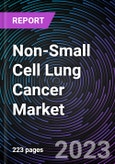This report comes with 10% free customization, enabling you to add data that meets your specific business needs.
Non-Small Cell Lung Cancer Market based on Type
- Squamous Cell Carcinoma
- Large Cell Carcinoma
- Others
- Adenocarcinoma
Non-Small Cell Lung Cancer Market based on Treatment Type
- Chemotherapy
- Targeted Therapy
- Immunotherapy
Non-Small Cell Lung Cancer Market based on Distribution Channel
- Hospital Pharmacy
- Drug Store and Retail Pharmacy
- Online Pharmacy
Non-Small Cell Lung Cancer Market based on Geography
- North America
- Europe
- Asia Pacific
- Rest of the World
In terms of treatment type, the non-small cell lung cancer market is majorly segmented into Chemotherapy, Targeted Therapy and Immunotherapy. Among them the targeted therapy category holds the significant share in market. This is due to the specific clinical benefits which this therapy provides, such as low risk of negative effects and the availability of various targeted medicines. Also, more patients are choosing targeted therapy as a cancer treatment option because it is effective in up to 80% of cases.
In terms of distribution channel, the market is categorized into Hospital Pharmacy, Drug Store and Retail Pharmacy and Online Pharmacy. The Hospital Pharmacy segment is likely to have a maximum share in the market growth. This can accredited to the surge in the number of NSCLC patients being admitted to hospitals and the availability of qualified specialists in these settings.
Based on the geographical analysis the non-small cell lung cancer market is segregated into North America, Europe, Asia Pacific and Rest of the World. The North America region is anticipated to have the maximum share in the market. This is because of region's robust concentration of key companies, well-developed healthcare infrastructure, and increased public awareness of the significance of early cancer detection.
Furthermore, the global rise in the cancer cases fuels the global non-small cell lung cancer market over the estimated period. As per the American Cancer Society statistics from 2016, the majority of cases of SCLC occur in people between the ages of 60 and 80, with a worldwide death rate of 30,000 per year. Additionally, as per the WHO data, lung cancer is the second most common type of cancer in men and women, accounting for 1.59 million deaths. This fuels the global market growth.
The leading players of the market are F. Hoffmann-La Roche Ltd, Eli Lilly and Company, Bristol-Myers Squibb Company, Merck & Co., Inc., Novartis AG, Pfizer Inc., Astrazeneca, Celgene Corporation, Sanofi, and boehringer ingelheim.
As a result, smoking is the most common habit in the present scenario around the world which is the significant reason for all types of lung cancer. Specifically, smoking is the major reason for non-small cell lung cancer which enhances the scope of the present market.
Key reasons to purchase the report:
- The report analyzes the geographical highlights in terms of consumption of the product/service within the region also indicates the factors which are affecting the market within each region.
- The report consists of opportunities and challenges faced by the players in the global non-small cell lung cancer
- Provides competitive outlook which includes the market ranking of the key players, coupled with new product launches, partnerships, business expansions, and acquisitions.
Table of Contents
Companies Mentioned
- F. Hoffmann-La Roche Ltd
- Eli Lilly and Company
- Bristol-Myers Squibb Company
- Merck & Co., Inc.
- Novartis AG
- Pfizer Inc.
- Astrazeneca
- Celgene Corporation
- Sanofi
- boehringer ingelheim








